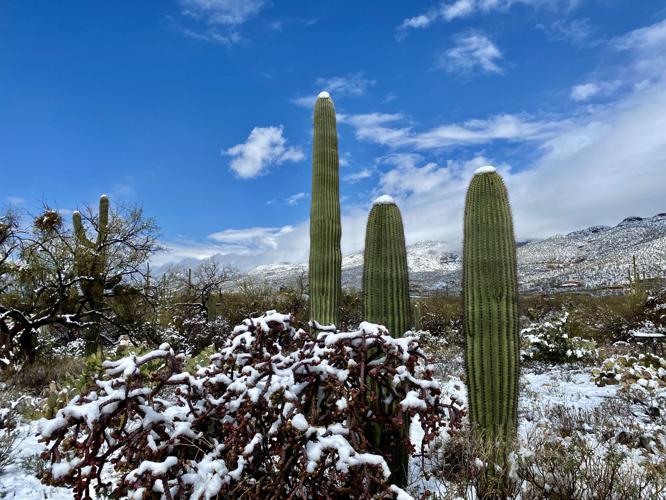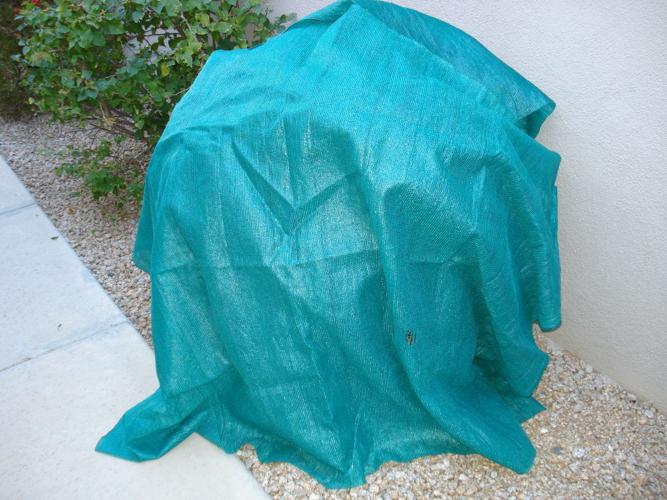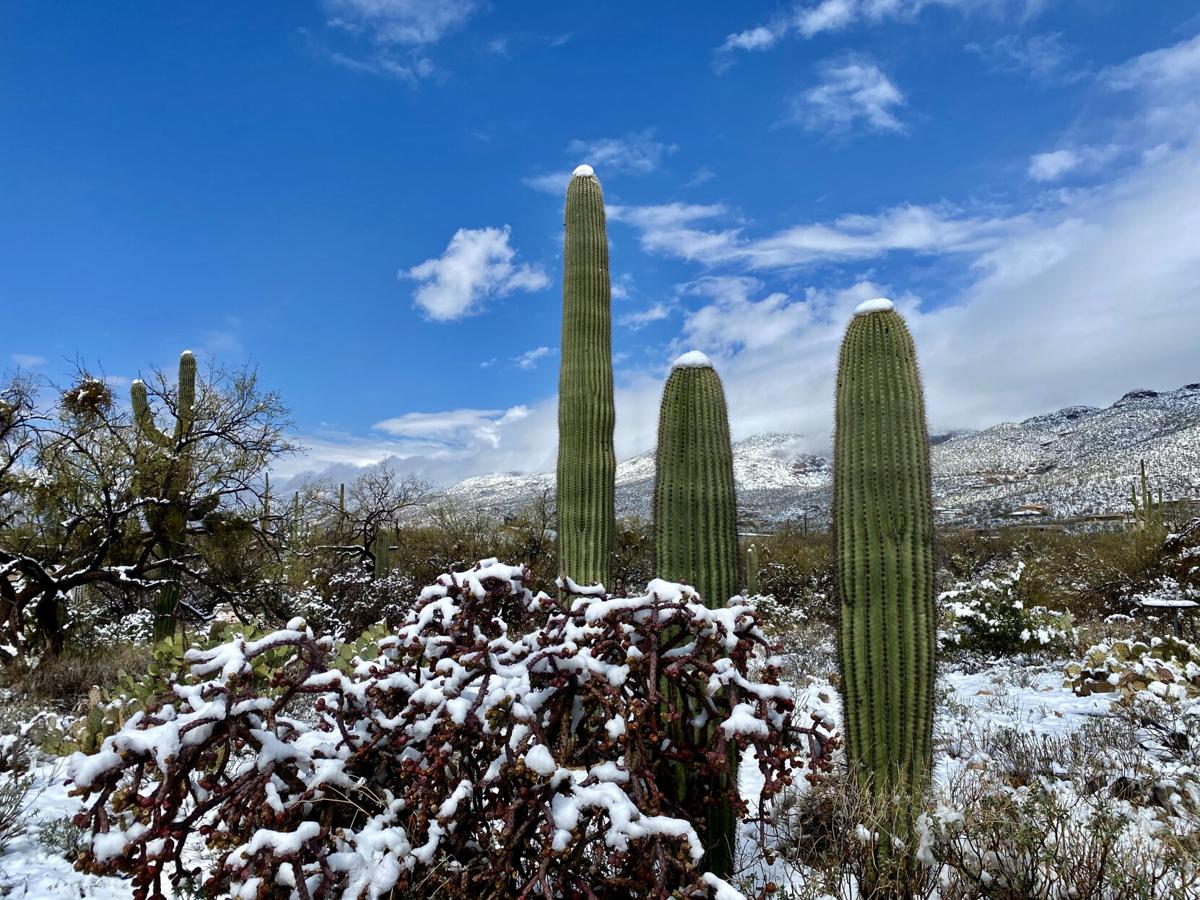Despite our recent balmy weather, we’re getting close to the time of year when we can expect some frosts in Tucson. Depending on your location and microclimate, and your choice of plants, you might want to consider some frost protection when those cold air masses finally come through our valley.
According to the National Oceanic and Atmospheric Administration, Tucson's average first frost date over the past 30 years has been around Dec. 3, while the last frost has been Feb. 7. These dates are just guidelines, however. If you are at a higher elevation, near a wash or valley, or have other microclimate features, your property may have frost dates that vary from these averages.
For example, higher elevations generally have colder weather, as do valleys and washes because cold air sinks and flows along the lowest contours of the ground. If your yard is near a canyon, you will have colder air moving down from the mountains during the nights. On the other hand, if you have a yard facing southwest with surrounding walls and hardscaping, you will likely experience warmer temperatures.
In the Tucson area, frosts are much more common than hard freezes (although these do happen). Hard freezes that last several days are more difficult to protect against, while overnight frosts usually don’t harm plants permanently.
Selection of plants and their placement is key for frost protection, and of course takes place before you even plant anything. In an ideal world, that fussy Meyer lemon tree would be in your nice, west-facing sunny patio, rather than on the east, shady side of your property. However, you may be stuck with plants that were poorly placed by prior owners, or ones that you planted before you were familiar with the microclimates in your yard. In that case, read on for some tips on protecting your green friends.
What to protect
In leafing plants, flowers are killed first, followed by new leaves, older leaves, stems and trunks. Plants that are native to warmer climates tend to be less frost tolerant. This includes citrus (particularly lemons and limes), tropical trees and shrubs (like bananas and some palms), and non-hardy succulents. Newer plants are at higher risk of damage than plants that are well-established. Container plants can also be more easily damaged, since roots are often less hardy than stems and leaves. The soil insulates the plants’ roots, but in a container, there is much less insulation.
You may also need to protect some cacti. For frost temperatures, cover the growing portion of the cactus only (right at the top of the stems). If these get damaged, that portion of the cactus will no longer grow.
If your plants are small enough to move indoors, this is probably your best strategy. On the other hand, if you have a 20-foot palm tree in your yard, it’s not likely that you can do anything about it in case of a cold snap. Focus your energies on the small trees and shrubs. Make sure you know what temperatures your plants can tolerate so that you can be ready.
You may choose not to fuss with some plants and just accept some frost damage (for example on bougainvillea or other less-hardy shrubs like Tecoma "Orange Bells" or cape honeysuckle). If you go this route, keep in mind that you should not prune the damaged stems off until after all danger of frost has passed — if you do, you will likely cause more damage to the plant. Pruning will stimulate new growth, which will then be killed off with the next frost. Also, the killed stems protect the living plant tissue from further damage. So be prepared to look at a dead-looking plant until late February or early March!
When to protect
The general weather forecast includes frost and freeze warnings and is your best bet for identifying the times you need to go out to cover your plants. Just looking at forecasted temperatures can be misleading, since different areas of Tucson have very different microclimates. You can check out the Weather Underground map for a more finely-tuned map of temperatures in your area.
You also need to consider microclimates in your yard. As mentioned already, being near washes or at higher elevations means you will have cooler nighttime temperatures than the forecast. A very helpful tool to figure out your yard’s microclimates is a temperature sensor with minimum and maximum temperature recording like this one. I recommend hanging several of these in your yard in different spots (out of direct sun) to determine the hot and cold spots. They will record your daily temperatures and send them wirelessly to a display inside your house. They will also indicate your minimum and maximum temperature for the year, which will be very helpful as you plan where to put your sensitive plants.
Plants are also more likely to get damaged if it’s one of the first frosts of the season, particularly after a warm fall like we’ve had this year. Similarly, frosts at the end of winter, when the weather has started warming up, can also result in more frost damage. Take extra care to protect your plants at the start and end of the winter season.
Wind will also make frost damage more likely. If your property is a windy one, you may want to protect plants once nighttime temperatures get close to freezing, even if there’s no specific frost warning for your area.
How to protect
Watering plants a couple of days before the frost and keeping the soil evenly moist will help protect your plants. A dehydrated plant is at higher risk of damage than a well-watered one.
Make sure you are mulching to protect the roots — mulch is insulating, which is both good and bad. It will help keep your soil from freezing, but it will also keep it from heating up much during the day. For sensitive trees, you may try to move the mulch off the soil during the day and moving it back at night. For container plants, you may want to wrap the containers in blankets or other insulating material.

Cover plants with frost cloth that reaches down to the soil for maximum protection.
You can use sheets, towels, and frost cloths to cover your plants. Frost cloths (like these) are generally more effective in protecting plants in severe frosts. Make sure you drape the cloth gently over the plant and let it drape down to the soil like a curtain. This keeps the air under the cloth insulated and allows the heat which has built up in the soil during the day to radiate into the covered area and warm the plant. If there is wind, weigh down the edges of the cloth using stones or other heavy objects.
You can also put a frame over the plant and drape the cloth over it to avoid damaging the foliage with the weight of the cloth. Make sure the frame isn’t touching the plant and that the cloth drapes down to the ground.
In case of a hard freeze
There are some additional steps you can take in case of a severe freeze. You can protect trunks and larger stems by wrapping them in insulating frost cloth or other material. In grafted trees, make sure you protect the graft site — if this is damaged, the plant will resprout from the rootstock.
You can also hang incandescent lights under the frost cloth canopy for warming. You can use standard Christmas lights or outdoor-safe hanging lights. Make sure you don’t use LED lights — they don’t give off the heat your plants will need. If you have a frame to create a canopy, you can also use heaters under the frost cloths, but be very careful not to create a fire hazard.
If despite all your efforts your fruit freezes, you can harvest it and juice it, pickle it, or dry it in a food dehydrator.
What not to do
Finally, here are some things to avoid.
- Don’t use plastic. It does not provide any insulation and can make frost damage worse if it’s touching the plant.
- Don’t prune the dead portion in case of frost damage; you will stimulate plant growth at a time when it is most vulnerable to cold damage. Wait until all danger of frost has passed. This will also help you identify what parts of the plant are still alive.
- Don’t prune plants once fall temperatures come. This stimulates growth.
- Don’t leave frost protection on for days at a time — it will result in higher temperatures under the cloth which may trigger the plant to start putting out fresh growth. Take frost protection off during the day and re-apply at night.
- Don’t use nitrogen fertilizers after August. These will encourage new growth that will be very sensitive to frost and freezing.






